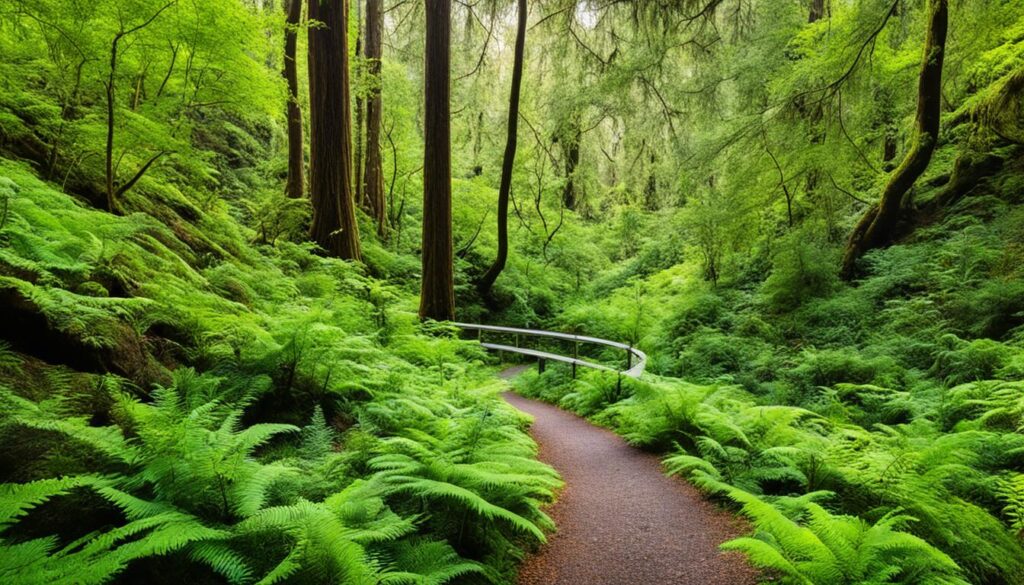Did you know that Victoria is implementing Wildlife Corridor Initiatives to connect habitats and support biodiversity? These initiatives are playing a crucial role in protecting critically endangered species and restoring their habitats in Victoria.
Victoria is home to unique species such as the Helmeted Honeyeater and the lowland Leadbeater’s Possum, which are facing habitat loss and degradation. Through the restoration of the Upper Yarra Sewage Treatment Plant site, these initiatives are working towards ensuring the survival and thriving of these species under a changing climate.
Key Takeaways:
- Victoria is implementing Wildlife Corridor Initiatives to connect habitats and support biodiversity
- The initiatives aim to protect critically endangered species such as the Helmeted Honeyeater and the lowland Leadbeater’s Possum
- Restoration of the Upper Yarra Sewage Treatment Plant site creates a secure habitat for these species
- The initiatives focus on creating climate-resilient habitats and promoting ecological connectivity
- Collaborative partnerships are essential in guiding the restoration process
Importance of Habitat Restoration in Wildlife Corridor Initiatives
Habitat restoration plays a crucial role in Victoria’s Wildlife Corridor Initiatives. Our restoration efforts are focused on the Upper Yarra Sewage Treatment Plant site, which was once part of a vast swamp forest and served as the natural habitat for critically endangered species. Through the restoration process, we are creating a habitable environment that supports the survival and long-term viability of these species.
The restoration includes the creation of a mixture of woodland and wetland habitats, carefully designed to mimic the diverse ecosystem that these species depend on. By utilizing recycled water from the treatment plant as a water source, we are able to sustain the animals and recreate the swampy habitat they rely on.
Habitat restoration not only provides a home for these endangered species but also contributes to the overall protection of biodiversity. By restoring and preserving these habitats, we are promoting the recovery of native flora and fauna, enhancing ecosystem services, and safeguarding the delicate balance of Victoria’s natural environment.
The Impact of Habitat Restoration:
- Provides a suitable habitat for critically endangered species
- Promotes the recovery of native flora and fauna
- Enhances ecosystem services
- Contributes to the protection of biodiversity
Through our habitat restoration efforts, we are taking significant steps towards preserving Victoria’s unique wildlife and ensuring the long-term sustainability of our precious ecosystems.
| Benefits of Habitat Restoration in Wildlife Corridor Initiatives |
|---|
| Promotes the recovery of endangered species |
| Enhances biodiversity protection |
| Restores ecosystem services |
| Preserves Victoria’s natural environment |
Collaborative Approach in Wildlife Corridor Initiatives
In Victoria’s Wildlife Corridor Initiatives, a collaborative approach is vital to the success of the project. We recognize that partnerships with environmental organizations, Traditional Owner partners, and other stakeholders are essential in guiding the restoration process and ensuring the long-term care of the habitat. Working together, we can achieve the shared goal of restoring biodiversity and creating a thriving habitat for critically endangered species.
Zoos Victoria, Greening Australia, Melbourne Water, Jacobs, and Spiire have come together with Yarra Valley Water to restore biodiversity at the Upper Yarra Sewage Treatment Plant site. This collaboration brings a wealth of expertise in ecology, habitat restoration, and ecosystem management, allowing us to implement effective strategies that benefit the habitat and wildlife.
By pooling our knowledge and resources, we can maximize the impact of our efforts and achieve better outcomes for the critically endangered species. Our collaborative approach ensures that multiple perspectives and insights are considered, leading to innovative solutions and more comprehensive habitat restoration.
Together, we are implementing a range of strategies and techniques to restore and protect the habitat. This includes habitat enhancement, vegetation planting, removal of invasive species, and monitoring of ecosystem health. Each partner contributes their unique expertise, playing a crucial role in the overall success of the Wildlife Corridor Initiatives.
Through collaboration, we can build a stronger foundation for habitat restoration and conservation. By working together, we can create a habitat that is resilient, sustainable, and capable of supporting a diverse range of species for generations to come.
| Partners | Expertise |
|---|---|
| Zoos Victoria | Wildlife conservation and research |
| Greening Australia | Habitat restoration and biodiversity conservation |
| Melbourne Water | Water management and ecosystem health |
| Jacobs | Environmental engineering and consulting |
| Spiire | Ecological planning and design |
Creating Climate-Resilient Habitats in Wildlife Corridor Initiatives
Climate resilience is a key focus of Victoria’s Wildlife Corridor Initiatives. As we restore the Upper Yarra Sewage Treatment Plant site, our goal is to create habitats that can withstand the challenges posed by a changing climate.
To ensure the sustainability of these habitats, we have implemented a unique strategy: utilizing recycled water from the treatment plant. By doing so, we can maintain these habitats even during droughts when surface water flows are scarce. This innovative approach not only supports the survival of critically endangered species but also enhances the overall biodiversity and ecological connectivity of the area.
By incorporating recycled water into our ecosystem, we minimize the impact of water scarcity on vulnerable habitats. This climate-resilient solution not only provides a constant water source for the habitat but also reduces reliance on traditional water sources, preserving them for other critical needs.
The Benefits of Recycled Water in Habitat Restoration:
- Ensures a consistent water supply during periods of drought
- Reduces dependence on surface water, preserving it for other uses
- Minimizes the risk of habitat destruction due to water scarcity
- Allows for the successful restoration and maintenance of unique woodland and wetland environments
- Enhances the overall biodiversity and ecological connectivity of the area
By creating climate-resilient habitats through the utilization of recycled water, we are taking a proactive approach to mitigate the impacts of climate change on our precious ecosystems. This forward-thinking strategy ensures the long-term survival and thriving of our critically endangered species, while also contributing to the preservation of Australia’s rich biodiversity.
“Utilizing recycled water in habitat restoration is a game-changer. It allows us to create sustainable habitats that can withstand the challenges of a changing climate, ultimately protecting our unique wildlife.” – Dr. Samantha Wilson, Ecologist
The Role of Connectivity in Wildlife Corridor Initiatives
Connectivity is a crucial component of Victoria’s Wildlife Corridor Initiatives. Our initiatives aim to connect fragmented habitats and create corridors that allow for the movement of species, promoting genetic diversity and reducing the risk of extinction.
By creating landscape corridors that span large areas, our initiatives provide opportunities for species to move and adapt to changing environments. This ensures that they can access essential resources and find suitable habitats to thrive. With increased connectivity, wildlife can disperse more freely, contributing to the long-term survival and resilience of populations.
Moreover, connectivity supports the exchange of genetic material between different populations, enhancing genetic diversity. This is vital for species’ ability to adapt to environmental changes, increasing their chances of survival in the face of challenges such as habitat loss and climate change.
Our focus goes beyond simply providing corridors for species. We also strive to create larger restored habitats that can support entire populations. By restoring and preserving larger areas, we enhance biodiversity preservation and create robust ecosystems that can support a variety of species.

| Benefits of Connectivity in Wildlife Corridor Initiatives |
|---|
| Promotes genetic diversity |
| Reduces the risk of extinction |
| Facilitates species movement and adaptation to changing environments |
| Enhances the long-term survival and resilience of populations |
| Supports the exchange of genetic material |
| Creates larger restored habitats |
| Enhances biodiversity preservation |
“Connectivity is crucial for wildlife conservation. It allows species to find suitable habitats and adapt to changing conditions, reducing the risk of extinction and promoting genetic diversity.”
– Dr. Emma Johnson, Ecologist
Benefits of Wildlife Corridors in Climate Change Adaptation
Wildlife corridors play a crucial role in climate change adaptation, offering a range of significant benefits. These corridors provide vital pathways for species to naturally disperse and move to more favorable areas as the climate changes, reducing the need for human intervention. By facilitating the natural movement of species, wildlife corridors promote gene flow, increase genetic diversity, and enhance the evolutionary resilience of wildlife populations.
As climate change continues to impact ecosystems, wildlife corridors serve as essential conduits for species to access suitable habitats. These corridors ensure that populations can maintain connectivity and adapt to shifting environmental conditions, helping to safeguard biodiversity and ensure the long-term viability of species.
“Wildlife corridors are lifelines for species in the face of climate change. By providing safe passage and connecting habitats, these corridors enable species to navigate changing environments and maintain population viability.”
Victoria’s Wildlife Corridor Initiatives contribute significantly to climate change adaptation efforts. By restoring and connecting habitats, these initiatives create a network of wildlife corridors that support the movement and resilience of wildlife populations. As corridors enable species to shift and adapt, they promote the preservation of biodiversity and contribute to the overall health and sustainability of ecosystems.
| Benefits of Wildlife Corridors in Climate Change Adaptation |
|---|
| Facilitates natural dispersal of species to climatically suitable areas |
| Promotes gene flow and genetic diversity |
| Enhances the evolutionary resilience of wildlife populations |
| Provides essential pathways for species to access suitable habitats |
| Supports the long-term viability of populations |
| Contributes to the preservation of biodiversity and ecosystem health |
Designing Effective Wildlife Corridors in Victoria
In Victoria’s Wildlife Corridor Initiatives, the design of wildlife corridors plays a critical role in ensuring the success of biodiversity conservation efforts. To create effective corridors, we need to consider various factors that contribute to their functionality and long-term viability.
Firstly, it is essential to plan corridors at a regional or continental level to establish evolutionary connectivity. This approach allows for gene exchange and range expansions among different populations, promoting genetic diversity and increasing the resilience of species to environmental changes. By creating corridors that span large areas, we provide pathways for wildlife to move and adapt, ultimately preserving biodiversity.
Strategic location is another key consideration in designing effective corridors. It is crucial to identify areas with valuable biodiversity and locate corridors along climatic gradients. By doing so, we enhance the chances of supporting a rich variety of species and providing them with suitable habitats. Additionally, locating corridors strategically can minimize the impact of climate change, as species can easily migrate to more favorable areas.

Buffer zones are integral to ensuring the success of wildlife corridors. By designing buffers along the edges of the corridors, we can reduce the negative effects of habitat fragmentation and edge effects. These buffers create transition zones that help minimize the impact of human activities and provide additional habitat for species. Incorporating existing habitat within the corridors further enhances their effectiveness and enables seamless connectivity between fragmented landscapes.
In Victoria, these principles are incorporated into the design of wildlife corridors as part of the collaborative efforts among various stakeholders. By working together with environmental organizations, Traditional Owner partners, and other stakeholders, Victoria’s Wildlife Corridor Initiatives aim to create a robust network of corridors that supports biodiversity conservation and enhances ecosystem resilience.
The Impact of Wildlife Corridors on Conservation Planning
Wildlife corridors play a crucial role in conservation planning, contributing to the protection and preservation of biodiversity. These corridors serve as vital pathways that connect fragmented habitats, allowing for the movement of species and promoting ecological connectivity. By incorporating wildlife corridors into conservation planning, we ensure the long-term viability of species and contribute to the overall health and resilience of ecosystems.
Conservation planning involves identifying priority areas for habitat restoration and connectivity. Wildlife corridors help guide these efforts by highlighting key locations where restoration and conservation interventions can have the greatest impact. Through careful analysis and mapping, we can identify areas with high species richness, endangered species populations, and important ecological processes that require protection.
A crucial aspect of conservation planning is the implementation of effective strategies and policies. Wildlife corridors provide essential information for developing and implementing these conservation initiatives. They offer insights into the spatial distribution of habitats, species movement patterns, and potential barriers that may impede ecological connectivity. Such information allows us to formulate targeted strategies that enhance the effectiveness of conservation efforts.
Ecological connectivity is essential for maintaining healthy and thriving ecosystems. Wildlife corridors act as bridges, enabling species to access food sources, breeding grounds, and new territories. By safeguarding and restoring these connectivity pathways, we create opportunities for genetic exchange, reduce the risk of inbreeding, and promote the long-term viability of species.
The impact of wildlife corridors extends beyond the preservation of individual species. By connecting habitats and facilitating species movement, these corridors enhance ecosystem preservation as a whole. They promote the flow of energy, nutrients, and ecological processes across different landscapes, contributing to the overall health and resilience of ecosystems.
Let’s take a look at the table below to understand the impact of wildlife corridors on conservation planning:
| Impact | Description |
|---|---|
| Enhanced Biodiversity | Wildlife corridors facilitate species movement, allowing for gene flow and promoting genetic diversity. This contributes to the preservation of biodiversity within and across habitats. |
| Ecosystem Resilience | By connecting habitats and facilitating ecological processes, wildlife corridors enhance the resilience of ecosystems to environmental changes and disturbances. |
| Protection of Endangered Species | Wildlife corridors help safeguard fragmented populations of endangered species by providing avenues for dispersal, thereby reducing the risk of extinction. |
| Promotion of Adaptation | Through wildlife corridors, species can access suitable habitats, aiding their adaptation to a changing climate and increasing their chances of survival. |
| Improved Ecosystem Functioning | Ecological connectivity facilitated by wildlife corridors promotes ecosystem functioning, including pollination, seed dispersal, and nutrient cycling. |
As conservation planning continues to evolve, the integration of wildlife corridors into strategies and policies is essential. By recognizing the importance of ecological connectivity and incorporating these corridors into our conservation efforts, we can ensure the preservation of biodiversity and the long-term sustainability of our ecosystems. Victoria’s Wildlife Corridor Initiatives are at the forefront of conservation planning, actively working to protect and connect habitats, contributing to ecological connectivity and the conservation of Australia’s unique wildlife.
Conclusion
Victoria’s Wildlife Corridor Initiatives are playing a crucial role in connecting habitats and safeguarding biodiversity. Through collaborative efforts, habitat restoration, and climate resilience, these initiatives are driving conservation planning forward. By establishing effective wildlife corridors and promoting ecological connectivity, Victoria is actively working towards the preservation of critically endangered species and the overall health of ecosystems. The successful implementation of these initiatives underscores the significance of long-term partnerships, well-informed decision-making, and a steadfast commitment to ecological restoration. Victoria’s Wildlife Corridor Initiatives serve as a model for sustainable conservation practices and the protection of Australia’s unique wildlife.
These initiatives serve as vital stepping stones towards creating a connected network of habitats that facilitate the movement of species, promote gene flow, and reduce the risk of extinction. By establishing wildlife corridors, Victoria is actively enhancing biodiversity protection and ecosystem preservation. The initiatives prioritize landscape-scale planning and ensure the inclusion of valuable biodiversity hotspots, contributing to the long-term viability of species and the overall health of ecosystems. Through their dedication to creating climate-resilient habitats and fostering ecological connectivity, Victoria’s Wildlife Corridor Initiatives are at the forefront of conservation efforts in Australia.
In conclusion, Victoria’s Wildlife Corridor Initiatives demonstrate the power of collaborative action and informed conservation planning. By forging partnerships, restoring habitats, and prioritizing climate resilience, these initiatives are paving the way for the protection of critically endangered species and the preservation of biodiversity. Victoria’s commitment to ecological restoration sets an example for sustainable conservation practices and underscores the importance of long-term stewardship. As we continue to prioritize the connection of habitats, we contribute to the legacy of wildlife conservation and safeguard the natural heritage of Victoria for future generations.
FAQ
What are Wildlife Corridor Initiatives?
Wildlife Corridor Initiatives are conservation projects aimed at connecting habitats to support biodiversity and enable the movement of species.
Why is habitat restoration important in Wildlife Corridor Initiatives?
Habitat restoration plays a crucial role in creating suitable environments for endangered species and enhancing biodiversity protection.
How does the collaborative approach contribute to Wildlife Corridor Initiatives?
The collaborative approach involving partnerships with various stakeholders ensures the effective restoration and long-term care of habitats.
How do Wildlife Corridor Initiatives create climate-resilient habitats?
By using recycled water and implementing climate-adaptive strategies, Wildlife Corridor Initiatives create habitats that can withstand the challenges of a changing climate.
What is the role of connectivity in Wildlife Corridor Initiatives?
Connectivity is essential in connecting fragmented habitats and allowing for the movement of species, promoting genetic diversity and reducing the risk of extinction.
What are the benefits of wildlife corridors in climate change adaptation?
Wildlife corridors provide opportunities for species to access suitable habitats and maintain population viability, thereby enhancing their resilience to environmental changes.
How are effective wildlife corridors designed in Victoria?
Wildlife corridors are strategically planned at a regional or continental level, taking into account biodiversity hotspots and climate gradients to ensure gene exchange and range expansions.
What is the impact of wildlife corridors on conservation planning?
Wildlife corridors guide conservation efforts by identifying priority areas for restoration, connectivity, and implementing effective conservation strategies and policies.
How do Victoria’s Wildlife Corridor Initiatives contribute to biodiversity protection?
Victoria’s Wildlife Corridor Initiatives connect habitats, restore biodiversity, and preserve ecosystems for the long-term survival of endangered species and overall ecosystem health.
